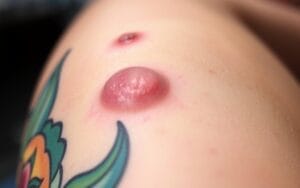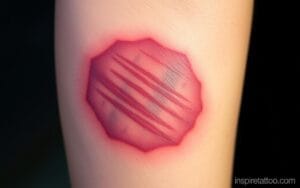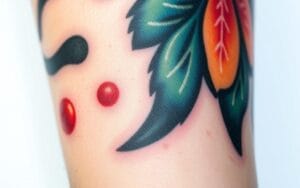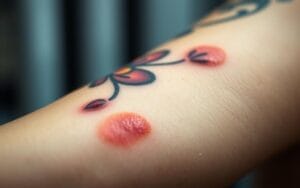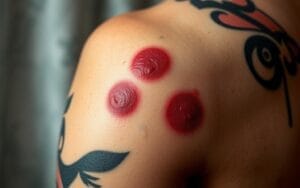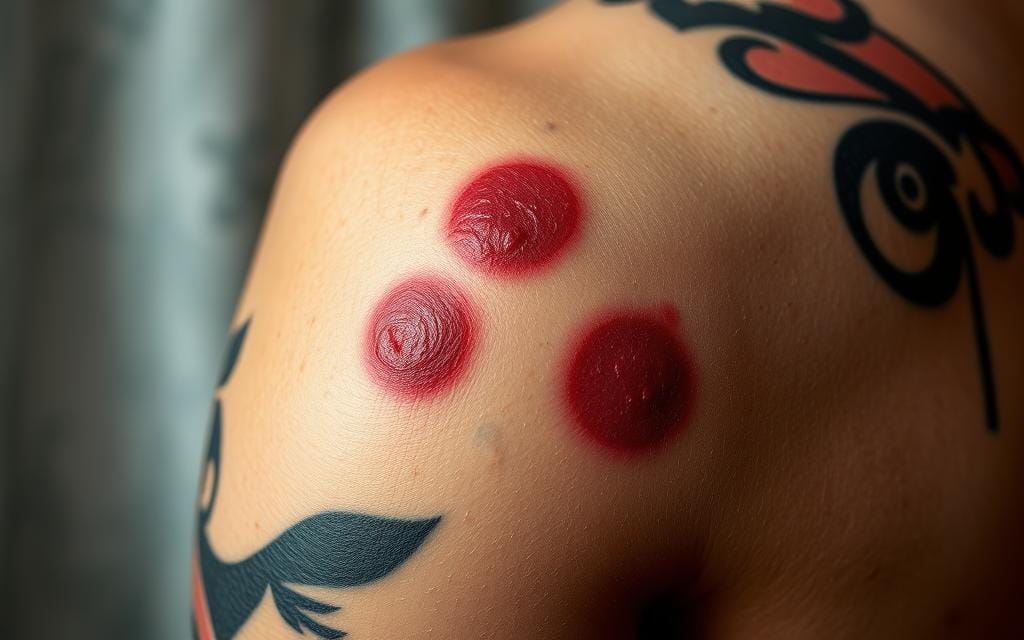Getting a tattoo is exciting, but it comes with side effects. Many wonder, is it normal to bruise after a tattoo? Yes, it is. Bruising happens because the tattoo needle punctures the skin, affecting blood vessels. This usually leads to temporary bruising, which is part of healing.
Understanding bruising can make you feel more at ease with your tattoo. Whether you’re new to tattoos or have many, knowing what to expect helps. So, is it normal for tattoos to bruise? Let’s explore this further to help you understand.
Key Takeaways
- Bruising after a tattoo is a common and normal reaction.
- The tattooing process involves hundreds of needle pricks, which can cause bruising.
- Bruising typically fades within a week but can vary depending on the individual.
- Proper aftercare can help minimize bruising and promote healing.
- If bruising worsens or persists, it may indicate an infection and require medical attention.
Understanding Tattoo Bruising: A Natural Response, Is it normal to bruise after a tattoo
Getting a tattoo can lead to a bruised area. This is because the tattoo machine keeps poking the skin, hurting the blood vessels under it. This results in a mild bruise around the tattoo, which is normal, more so in sensitive skin areas.
Why Bruising Occurs During Tattooing
During a tattoo, the needle goes deep into the skin, hitting the dermis layer. This can damage small blood vessels, causing bruising. The severity of the bruising varies based on skin sensitivity and the tattoo’s location.
The Role of Blood Vessels in Tattoo Bruising
Blood vessels are key in tattoo bruising. When the needle hits them, blood spills into the tissue, causing discoloration. This is why you might see a bruised look after your tattoo session.
Common Areas Most Prone to Bruising
Some body parts are more likely to bruise because of their skin thickness or bone proximity. Here’s a table showing the most common areas:
| Body Area | Reason for Bruising |
|---|---|
| Arms | Thin skin and frequent movement |
| Legs | Close to bones and veins |
| Torso | Delicate skin and soft tissue |
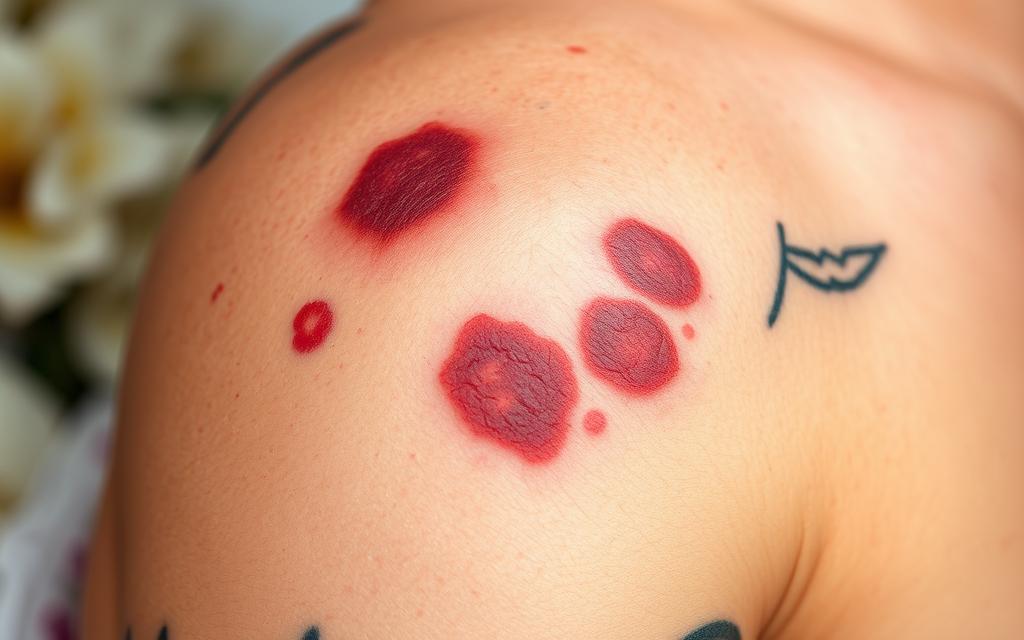
Knowing why bruising happens can make the healing process easier. Remember, a bruised tattoo area is a natural part of healing.
The Normal Appearance of a Bruised Tattoo
Getting a tattoo can lead to bruising around the inked area. This is a natural response to the trauma from the tattoo needle. So, can a tattoo bruise? Absolutely. Bruising is a typical part of the healing process and varies in appearance depending on the stage of recovery.
At first, the bruise may look red or dark purple. This is because the tattooing process irritates blood vessels. As the bruise heals, it will change colors. Do tattoos bruise while healing? Yes, and here’s what you can expect:
- Red or Purple: The bruise often starts with a reddish or purplish hue, indicating fresh trauma to the skin.
- Blue or Black: After a day or two, the bruise may darken to a blue or black color as blood pools under the skin.
- Green or Yellow: As healing progresses, the bruise may turn green or yellow, signaling the breakdown of blood cells.
- Light Brown: Lastly, the bruise fades to a light brown or skin tone before disappearing completely.
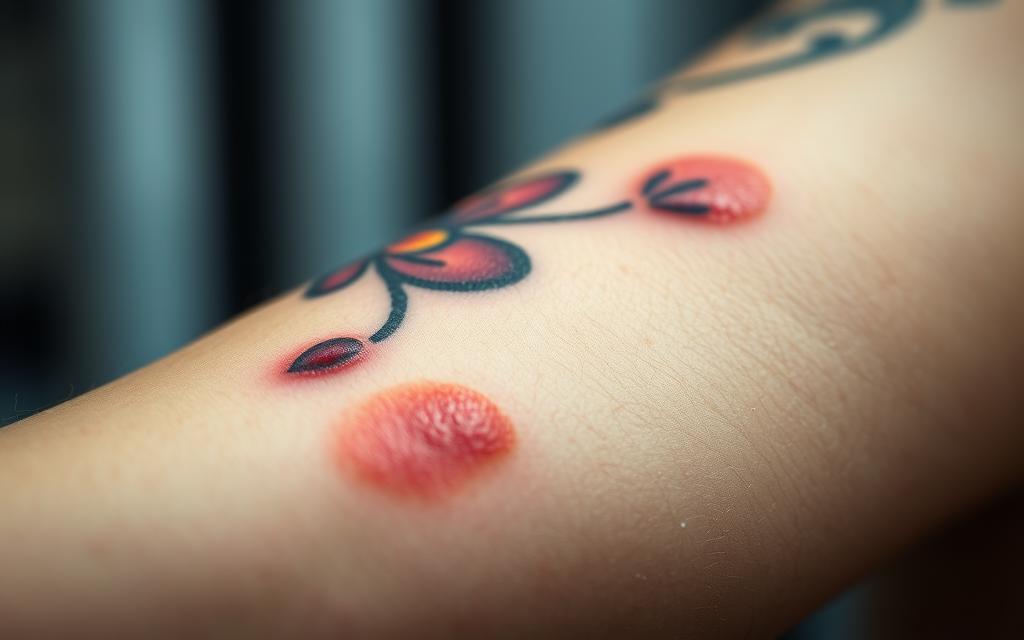
These color changes are a normal part of the healing process and usually resolve within a week or two. If you notice excessive swelling, worsening pain, or signs of infection, consult a professional immediately. Proper aftercare, including keeping the area clean and elevated, can help minimize bruising and speed up recovery.
Is It Normal to Bruise After a Tattoo: Expert Insights
Many people wonder if tattoos should bruise and if it’s a worry. Bruising is a common side effect of getting a tattoo. Experts from tattoo and medical fields share their insights on this.
What Professional Tattoo Artists Say
Tattoo artists often see clients with bruises around their tattoos, like on the inner wrist or elbow. They say bruising happens because of the needle’s repeated punctures irritating blood vessels. Light bruising is normal and usually goes away in a week.
Artists warn against getting tattoos over large bruises. It can mess up the design and healing.
Medical Perspective on Tattoo Bruising
From a medical view, bruising is a natural reaction to skin injury. If your tattoo is bruised, it’s because the needle hurt small blood vessels. This causes blood to pool under the skin.
Mild bruising is okay, but too much swelling, redness, or pain might mean an infection. If this happens, you should see a doctor right away.
Both tattoo artists and doctors stress the need for good aftercare. Keeping the area clean and moisturized helps reduce bruising and speeds up healing. If you notice anything odd, get professional help.
The Timeline of Tattoo Bruise Healing
Knowing how a new tattoo heals helps you care for it right. Bruising is normal and shows your body is healing. The healing time depends on your skin, tattoo spot, and how well you care for it.
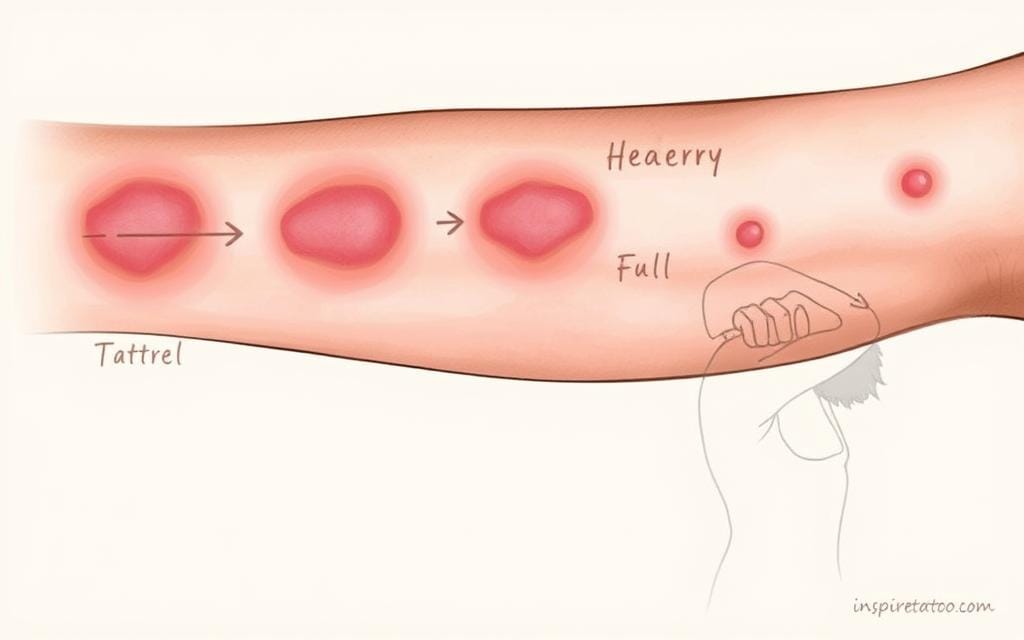
First 24 Hours After Getting Inked
In the first 24 hours, you might see redness, swelling, and bruising. This is because your body is fighting off infection. The bruise might look red or purple, based on your skin.
Days 2-7: Color Changes and Healing
As the bruise heals, it goes through colors like purple, green, and yellow. This is normal as your body absorbs the blood. You might also see scabbing and peeling, which means your skin is fixing itself.
When to Expect Complete Resolution
Most bruising goes away in a week or two. But, deeper skin layers might take longer. If the bruising doesn’t get better or gets worse, see a pro.
Here’s a quick overview of the tattoo healing stages:
- Stage One (Days 1-6): Redness, swelling, and initial scabbing.
- Stage Two (Days 7-14): Itching, flaking, and color changes in the bruise.
- Stage Three (Days 15-30): Bruising fades, and the tattoo appears fully healed.
Good aftercare is key to less bruising and faster healing. Keep the area clean, moisturized, and avoid tight clothes.
Factors That Influence Tattoo Bruising
Getting a tattoo often leads to bruising, but how much and for how long can change. Knowing what affects it can help you get ready for healing and feel less pain.
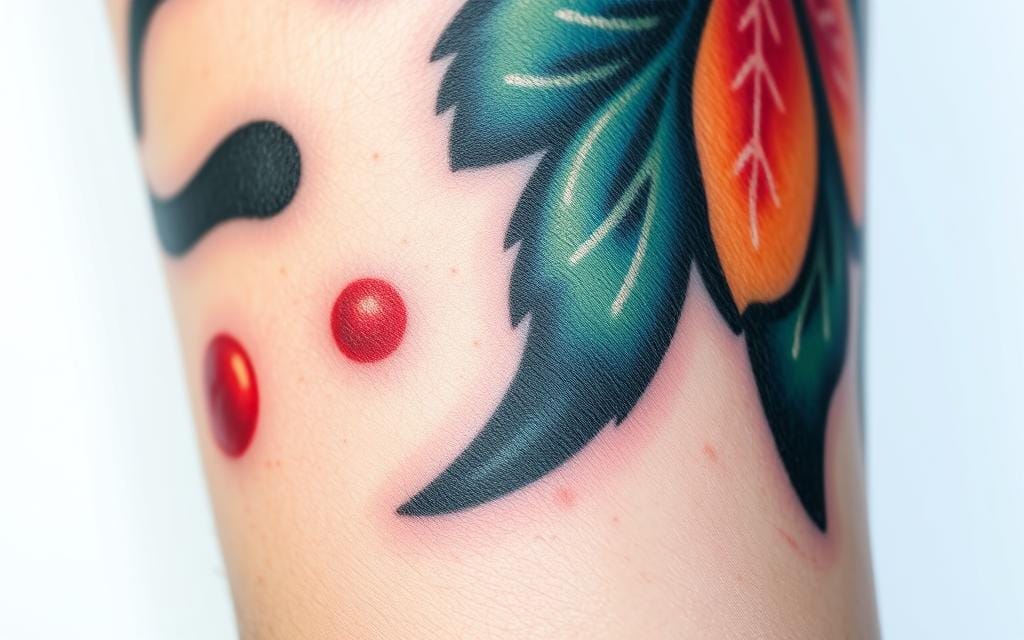
- Tattoo Location: Places like arms or legs, with thin skin, tend to bruise more. Collarbones and inner thighs are known for being tough to heal.
- Skin Type: People with sensitive skin might see more bruising on new tattoos. Those with thicker skin might not experience as much.
- Aftercare: Taking good care of your tattoo, like cleaning it gently and keeping it moisturized, can help prevent bruising.
Even though bruising is a normal part of getting a tattoo, knowing these factors can help you prepare. If you’re thinking, “Can you tattoo over a bruise?” it’s safer to wait until it’s fully healed to avoid problems.
Managing and Reducing Tattoo Bruising
Proper aftercare is key to less bruising and smooth healing. Whether it’s a bruise tattoo or a small tattoo blowout, the right steps help a lot. Here’s how to manage and reduce bruising well.
Immediate Aftercare Steps
- Apply a cold compress to the area for 10-15 minutes to reduce swelling and bruising.
- Elevate the tattooed area to minimize blood flow and prevent further bruising.
- Keep the area clean and moisturized to avoid irritation and promote tattoo blowout or healing.
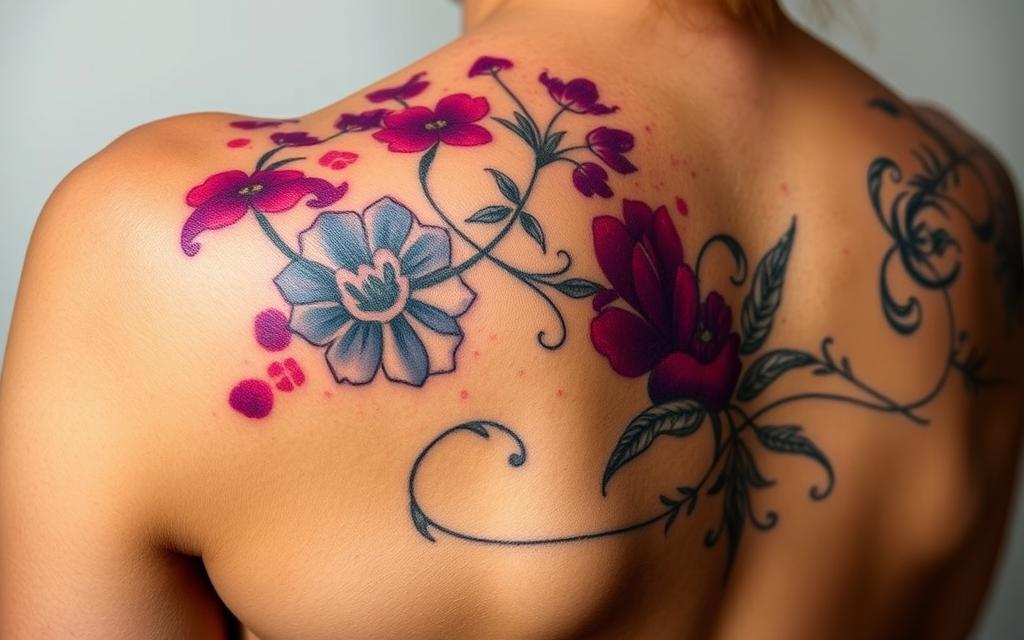
Natural Remedies for Bruising
- Use arnica gel or cream to reduce inflammation and speed up healing.
- Apply vitamin K cream to help fade bruises more quickly.
- Stay hydrated and maintain a diet rich in vitamins C and zinc to support skin recovery.
Professional Treatment Options
If bruising persists or is severe, see a professional. Laser therapy can reduce discoloration, and steroid injections might be used for extreme cases. Always get medical advice if symptoms or healing take too long.
By following these steps, you can manage bruising well and ensure your tattoo heals beautifully. Proper care not only reduces discomfort but also makes your tattoo look better.
Warning Signs: When Bruising Indicates a Problem
Bruising after a tattoo is common, but some signs can mean trouble. Knowing the difference between normal healing and complications is key. A healed tattoo should not have too much bruising or swelling. If you see unusual signs, act fast.
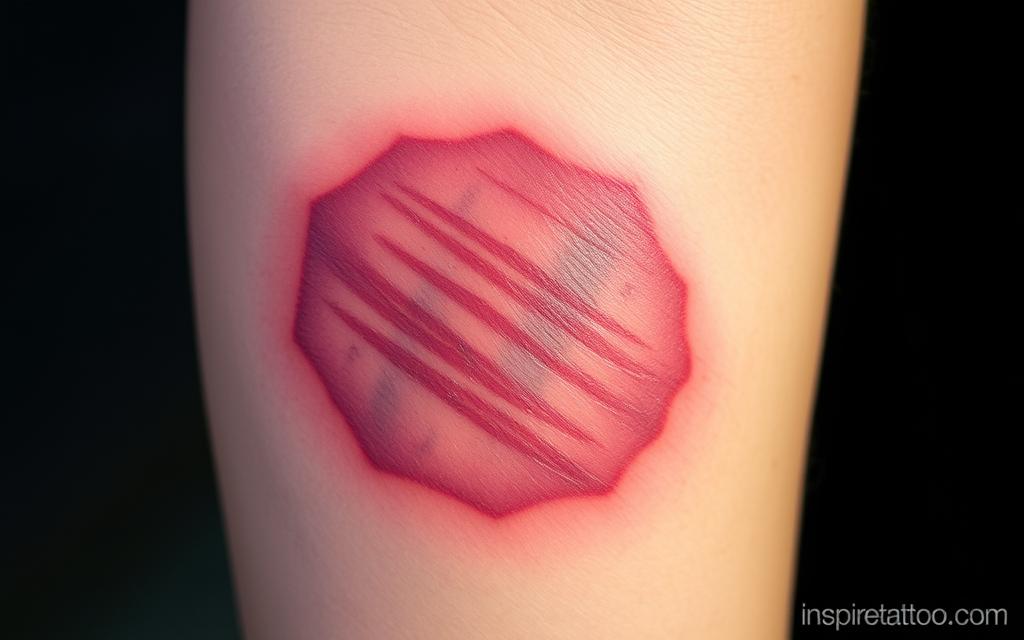
Differentiating Normal vs. Excessive Bruising
Normal bruising after a tattoo usually goes away in two weeks. The bruise on your inner arm might start red, then turn blue or purple. By day 10, it should start to fade to yellow or green. If it stays dark, gets bigger, or hurts more, it might be a sign of a problem.
Signs of Infection or Complications
Look out for redness, swelling, or warmth around your tattoo. These signs, with pus or fever, could mean an infection. If your bruise lasts more than two weeks, get help from a pro. Other warning signs include:
- Severe pain that doesn’t subside
- Unusual discharge or foul odor
- Lumps or hard areas under the skin
Ignoring these signs can cause serious problems. Always get medical help if you think your tattoo is not healing right.
Prevention Tips for Future Tattoos
Getting a bruise around a new tattoo can be scary. But, you can lower the risk with the right steps. Start by being proactive before, during, and after your tattoo session.
Pre-Tattoo Preparation
Make sure your body is ready. Drink lots of water and eat foods full of vitamins C and K. These help your skin and blood clotting. Also, stop taking blood-thinning meds like aspirin or ibuprofen a week before.
During the Tattoo Session
Talk to your tattoo artist about any worries. Pick someone with lots of experience and good techniques. Take breaks during long sessions to ease the skin stress.
Post-Tattoo Care Guidelines
Aftercare is key to avoid bruising. Clean the area with mild soap and water. Then, use a moisturizer to keep it moist. Don’t wear tight clothes or put too much pressure on it. Follow your artist’s advice to heal well and avoid bruising.
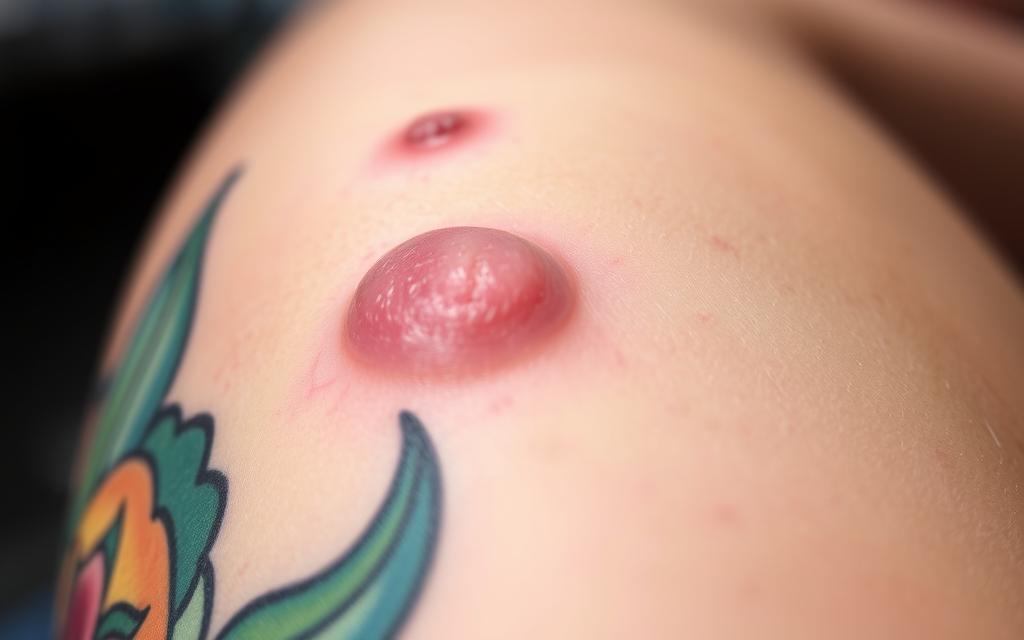
By following these tips, you can enjoy your tattoo without worrying about bruising.
Common Misconceptions About Tattoo Bruising
Bruising after a tattoo is normal and part of healing. Many wonder, “Is bruising normal after a tattoo?” Yes, it is, but myths can confuse us. Knowing these myths helps you feel more confident during your tattoo healing.
Some think bruising means they have an infection. But, mild bruising is common. Seeing 3 small bruises or 3 on different parts doesn’t always mean trouble. It’s usually your body reacting to the tattoo.
“Bruising is a sign that your body is healing, not a cause for alarm,” says a professional tattoo artist.
Another myth is that you can avoid bruising. While good care can help, some bruising is unavoidable, more so in sensitive spots. Here are more myths to watch out for:
- Bruising means the tattoo artist was unskilled.
- Only certain skin types bruise after tattoos.
- Bruising will ruin the final look of your tattoo.
By clearing up these myths, you can take better care of your tattoo. Remember, bruising is temporary and a part of healing.
Conclusion: Embracing the Healing Journey
Getting a tattoo is exciting, but you might have questions about healing. You might ask, “Why is my tattoo swollen?” or “Is it normal for a new tattoo to be red?” These are common worries. They show your body’s natural response to the tattoo.
Bruising and swelling are normal after getting a tattoo, more so in sensitive areas. Most cases clear up in a week. But, some might see swelling after a year, which could mean a problem. If your tattoo looks infected, with too much redness or warmth, get help fast.
Everyone heals differently. By following aftercare tips and being patient, your tattoo will heal well. See this time as a step to proudly show off your new tattoo.
FAQ
Is it normal to bruise after a tattoo?
Yes, it’s normal to bruise after getting a tattoo. This happens because the tattoo needle breaks blood vessels. This leads to bleeding and bruising in the area.
Why do tattoos cause bruising?
Tattoos cause bruising because the needle punctures blood vessels. This causes bleeding and bruises. Blood vessels are key because they supply blood to the area.
What is the normal appearance of a bruised tattoo?
A bruised tattoo looks different at different healing stages. At first, it might look red, which can worry some people. As it heals, it can turn purple, yellow, and green.
What do professional tattoo artists and medical experts say about tattoo bruising?
Tattoo artists and doctors say bruising is part of healing. But, watch for signs of infection like too much swelling, redness, or pain. If you see these, get medical help right away.
How long does it take for tattoo bruises to heal?
Healing time for tattoo bruises varies. It depends on skin type, tattoo location, and aftercare. But, most bruises heal in a week or two.
What factors influence the likelihood and severity of tattoo bruising?
Several things can affect how likely and severe tattoo bruising is. Tattoo location, skin type, and aftercare are important. Tattoos in sensitive areas or on sensitive skin might bruise more.
How can I manage and reduce tattoo bruising?
To manage bruising, follow good aftercare. Clean and moisturize gently. Applying a cold compress or elevating the area can also help. Natural remedies and professional treatments might also be useful.
When should I seek medical attention for tattoo bruising?
If you see a lot of bruising, swelling, or redness, it could be an infection. It’s important to know the difference between normal and excessive bruising. Seek medical help if you’re unsure.
How can I prevent future tattoo bruising?
To avoid bruising in the future, prepare well for your tattoo. Follow your artist’s advice and take good care of your tattoo after. Clean and moisturize it gently.
What are some common misconceptions about tattoo bruising?
Many people worry too much about tattoo bruising. It’s normal and not always a sign of infection. Understanding this can help reduce worry and anxiety.
